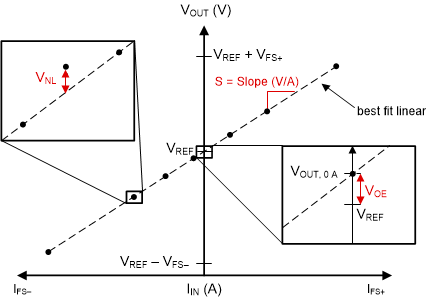ZHCSM20 June 2021 TMCS1100-Q1
PRODUCTION DATA
- 1 特性
- 2 应用
- 3 说明
- 4 Revision History
- 5 Device Comparison
- 6 Pin Configuration and Functions
- 7 Specifications
- 8 Parameter Measurement Information
- 9 Detailed Description
- 10Application and Implementation
- 11Power Supply Recommendations
- 12Layout
- 13Device and Documentation Support
- 14Mechanical, Packaging, and Orderable Information
8.1.1 Sensitivity Error
Sensitivity is the proportional change in the sensor output voltage due to a change in the input conductor current. This sensitivity is the slope of the first-order transfer function of the sensor, as shown in Figure 8-1. The sensitivity of the TMCS1100-Q1 is tested and calibrated at the factory for high accuracy.
 Figure 8-1 Sensitivity, Offset, and Nonlinearity Error
Figure 8-1 Sensitivity, Offset, and Nonlinearity ErrorDeviation from ideal sensitivity is quantified by sensitivity error, defined as the percent variation of the best-fit measured sensitivity from the ideal sensitivity. When specified over a temperature range, this is the worst-case sensitivity error at any temperature within the range.
Equation 2. eS = [(Sfit – Sideal) / Sideal] × 100%
where
- eS is the sensitivity error.
- Sfit is the best fit sensitivity.
- SIdeal is the ideal sensitivity.